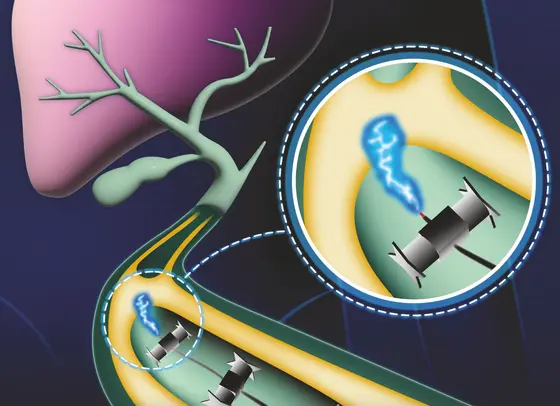The list of conceivable applications for miniature robots in medicine is long: from targeted drug application to sensing tasks and surgical procedures. An arsenal of robots has already been developed and tested for this range of tasks, from the nanometer to the centimeter scale.
However, the little helpers available today reach their limits in many tasks. For example, in endoscopic microsurgery. The required instruments are often too heavy for a single millimeter-sized robot to carry to its destination. Another common problem is that the robots often have to move by crawling. However, the surfaces of numerous body structures are covered with mucus on which the robots slip and cannot move.
“Spikes“ on the feet provide three times the propulsive force
A team led by Tian Qiu at the DKFZ in Dresden has now developed a solution for both of these problems: their TrainBot connects several individual robots on the millimeter scale. The units are equipped with improved anti-slip feet. Together, they are able to transport an endoscopic instrument. The TrainBot unit works wireless; an rotating magnetic field simultaneously controls the individual units. The magnetic control enables movements in a plane with the control of rotation. The external actuation and control system is designed for the distances at the human body scale.
Microsurgery in the bile duct
The Dresden-based DKFZ researchers have already used their robot convoy of three TrainBot units to simulate a surgical procedure. In the case of bile duct cancer, the bile duct often becomes blocked, causing bile to back up, which is a very dangerous situation for those affected. In this case, the occlusion must be opened after an endoscopic diagnosis. To do this, a flexible endoscope is inserted through the mouth into the small intestine and from there into the bile duct. One of the major difficulties here is for the endoscope to navigate around the sharp angle from the small intestine into the bile duct.
“This is where the flexible robot convoy can show its strengths,“ says the project leader Tian Qiu. His team demonstrated it using organs removed from a pig. The robot convoy was able to maneuver an endoscopic instrument for electrical tissue ablation in the bile duct. Once the tip of the wire electrode arrives at the site, electrical voltage is applied and a tissue blockage is gradually removed electrically, a procedure known as “electrocauterization“. The wire electrode used was 25 cm long and three and a half times as heavy as a TrainBot unit. “Afterwards, for example, another TrainBot convoy can bring a catheter for fluidic drainage or drug delivery,“ says Moonkwang Jeong, the first author of the paper, “After the promising results with the TrainBots in the organ model, we are optimistic that we will be able to develop teams of miniature robots for further tasks in endoscopic surgery.“
Moonkwang Jeong, Xiangzhou Tan, Felix Fischer, Tian Qiu: A Convoy of Magnetic Millirobots Transports Endoscopic Instruments for Minimally-Invasive Surgery
Advanced Science 2024, https://doi.org/10.1002/advs.202308382



